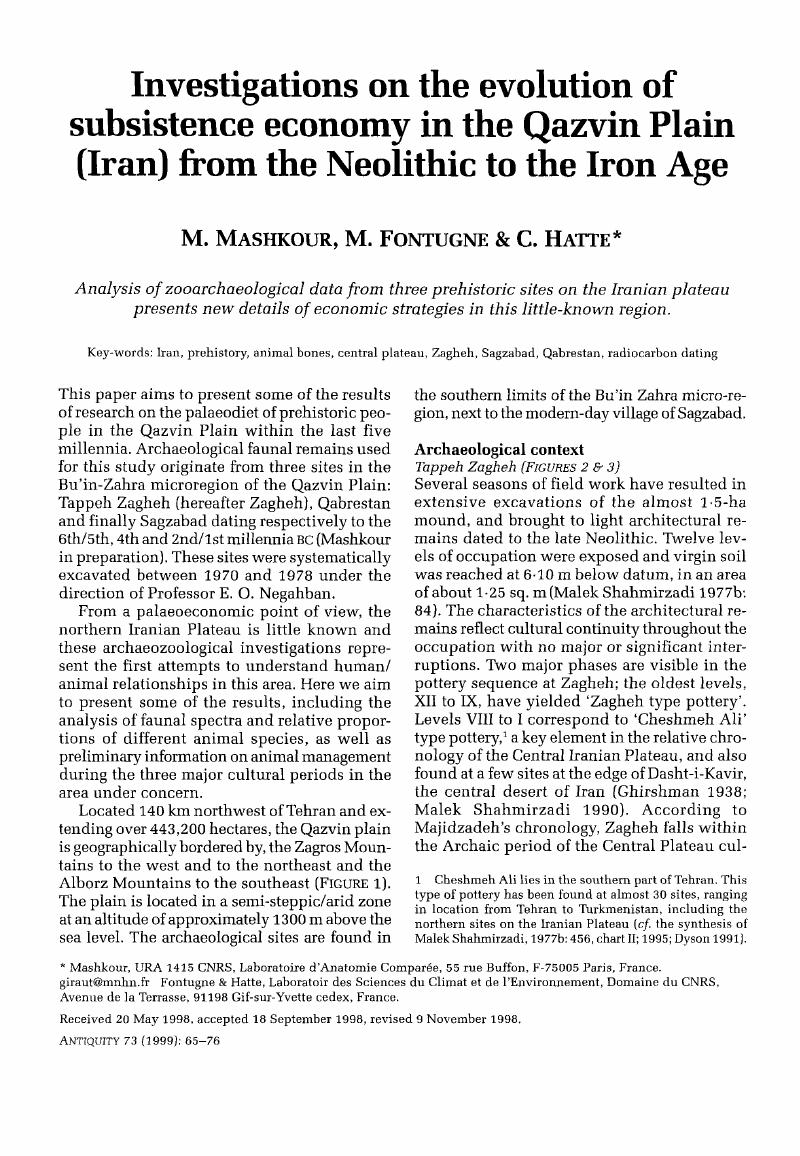Crossref Citations
This article has been cited by the following publications. This list is generated based on data provided by Crossref.
Eisenmann, Véra
and
Mashkour, Marjan
1999.
The small equids of Binagady (Azerbaidjan) and Qazvin (Iran): E. Hemionus Binagadensis nov. subsp. and E. Hydruntinus.
Geobios,
Vol. 32,
Issue. 1,
p.
105.
Bocherens, Hervé
Mashkour, Marjan
and
Billiou, Daniel
2000.
Palaeoenvironmental and Archaeological Implications of Isotopic Analyses (13C,15N) from Neolithic to Present in Qazvin Plain (Iran).
Environmental Archaeology,
Vol. 5,
Issue. 1,
p.
1.
Bocherens, Hervé
Mashkour, Marjan
and
Billiou, Daniel
2000.
Palaeoenvironmental and Archaeological Implications of Isotopic Analyses (<SUP>13</SUP>C, <SUP>15</SUP>N) from Neolithic to Present in Qazvin Plain (Iran).
Environmental Archaeology,
Vol. 5,
Issue. 1,
p.
1.
Coningham, R.A.E.
Fazeli, H.
Young, R.L.
Gillmore, G.K.
Karimian, H.
Maghsoudi, M.
Donahue, R.E.
and
Batt, C.M.
2006.
Socio-Economic Transformations: Settlement Survey in the Tehran Plain and Excavations at Tepe Pardis.
Iran,
Vol. 44,
Issue. 1,
p.
33.
ORLANDO, LUDOVIC
MASHKOUR, MARJAN
BURKE, ARIANE
DOUADY, CHRISTOPHE J.
EISENMANN, VÉRA
and
HÄNNI, CATHERINE
2006.
Geographic distribution of an extinct equid (Equus hydruntinus: Mammalia, Equidae) revealed by morphological and genetical analyses of fossils.
Molecular Ecology,
Vol. 15,
Issue. 8,
p.
2083.
Dyson, Robert H.
and
Thornton, Christopher R.
2009.
Shir-i Shian and the Fifth-Millennium Sequence of Northern Iran.
Iran,
Vol. 47,
Issue. 1,
p.
1.
Schmidt, Armin
Quigley, Mark
Fattahi, Morteza
Azizi, Ghasem
Maghsoudi, Mehran
and
Fazeli, Hassan
2011.
Holocene settlement shifts and palaeoenvironments on the Central Iranian Plateau: Investigating linked systems.
The Holocene,
Vol. 21,
Issue. 4,
p.
583.
Ponel, Philippe
Andrieu-Ponel, Valérie
Djamali, Morteza
Lahijani, Hamid
Leydet, Michelle
and
Mashkour, Marjan
2013.
Fossil beetles as possible evidence for transhumance during the middle and late Holocene in the high mountains of Talysch (Talesh) in NW Iran?.
Environmental Archaeology,
Vol. 18,
Issue. 3,
p.
201.
Maghsoudi, Mehran
Simpson, Ian A.
Kourampas, Nikos
and
Nashli, Hassan Fazeli
2014.
Archaeological sediments from settlement mounds of the Sagzabad Cluster, central Iran: Human-induced deposition on an arid alluvial plain.
Quaternary International,
Vol. 324,
Issue. ,
p.
67.
Crees, Jennifer J.
and
Turvey, Samuel T.
2014.
Holocene extinction dynamics of Equus hydruntinus, a late-surviving European megafaunal mammal.
Quaternary Science Reviews,
Vol. 91,
Issue. ,
p.
16.
Marghussian, A. K.
Coningham, R. A. E.
and
Fazeli, H.
2017.
The Evolution of Pottery Production During The Late Neolithic Period at Sialk On The Kashan Plain, Central Plateau of Iran.
Archaeometry,
Vol. 59,
Issue. 2,
p.
222.
Roberts, James
Weeks, Lloyd
Cable, Charlotte
Fillios, Melanie
Aali, Yaaqoub Youssef al
Radwan, Mansour Boraik
and
Zein, Hassan
2018.
The role of wild terrestrial animals in late prehistoric societies of south‐eastern Arabia: new insights from Saruq al‐Hadid.
Arabian Archaeology and Epigraphy,
Vol. 29,
Issue. 2,
p.
115.
Rezaei, Mohammad Hossein
and
Basafa, Hassan
2019.
The Impact of Geological Processes on the Location of Shahrake Firouzeh, a Prehistoric Site from NE Iran.
Ancient Asia,
Vol. 10,
Issue. ,
Verdugo, Marta Pereira
Mullin, Victoria E.
Scheu, Amelie
Mattiangeli, Valeria
Daly, Kevin G.
Maisano Delser, Pierpaolo
Hare, Andrew J.
Burger, Joachim
Collins, Matthew J.
Kehati, Ron
Hesse, Paula
Fulton, Deirdre
Sauer, Eberhard W.
Mohaseb, Fatemeh A.
Davoudi, Hossein
Khazaeli, Roya
Lhuillier, Johanna
Rapin, Claude
Ebrahimi, Saeed
Khasanov, Mutalib
Vahidi, S. M. Farhad
MacHugh, David E.
Ertuğrul, Okan
Koukouli-Chrysanthaki, Chaido
Sampson, Adamantios
Kazantzis, George
Kontopoulos, Ioannis
Bulatovic, Jelena
Stojanović, Ivana
Mikdad, Abdesalam
Benecke, Norbert
Linstädter, Jörg
Sablin, Mikhail
Bendrey, Robin
Gourichon, Lionel
Arbuckle, Benjamin S.
Mashkour, Marjan
Orton, David
Horwitz, Liora Kolska
Teasdale, Matthew D.
and
Bradley, Daniel G.
2019.
Ancient cattle genomics, origins, and rapid turnover in the Fertile Crescent.
Science,
Vol. 365,
Issue. 6449,
p.
173.
BLESA CUENCA, JOSÉ LUIS
2020.
Die Landwirtschaft der arischen Völker aus der frühen Eisenzeit: Tiere und Menschen im vorachämenidischen Mittelasien1.
Archaeofauna,
Vol. 29,
Issue. ,
p.
119.
Zaina, Federico
and
Nabati Mazloumi, Yasaman
2021.
A multi‐temporal satellite‐based risk analysis of archaeological sites in Qazvin plain (Iran).
Archaeological Prospection,
Vol. 28,
Issue. 4,
p.
467.
Emami, Mohammadamin
Vallcorba, Oriol
Rozatian, Amir Sayid Hassan
Hadian Dehkordi, Manijeh
Talaee, Hassan
and
Chapoulie, Remy
2021.
Synchrotron micro-XRD applied for the characterization of pottery from the Neolithic to Chalcolithic transitional period: a case study from Tappeh Zaghe, Iran.
The European Physical Journal Plus,
Vol. 136,
Issue. 1,
Rigaud, Solange
Queffelec, Alain
Le Bourdonnec, François-Xavier
Alisher kyzy, Saltanat
Ambrose, Stanley H.
Ledevin, Ronan
Kurbanov, Redzhep
Buzhilova, Alexandra
Berezina, Natalia
Ziganshin, Rustam H.
and
Shnaider, Svetlana
2023.
Exploring Hypotheses on Early Holocene Caspian Seafaring Through Personal Ornaments: A Study of Changing Styles and Symbols in Western Central Asia.
Open Archaeology,
Vol. 9,
Issue. 1,
Özkan, Mustafa
Gürün, Kanat
Yüncü, Eren
Vural, Kıvılcım Başak
Atağ, Gözde
Akbaba, Ali
Fidan, Fatma Rabia
Sağlıcan, Ekin
Altınışık, Ezgi N.
Koptekin, Dilek
Pawłowska, Kamilla
Hodder, Ian
Adcock, Sarah E.
Arbuckle, Benjamin S.
Steadman, Sharon R.
McMahon, Gregory
Erdal, Yılmaz Selim
Bilgin, C. Can
Togan, İnci
Geigl, Eva‐Maria
Götherström, Anders
Grange, Thierry
Özer, Füsun
and
Somel, Mehmet
2024.
The first complete genome of the extinct European wild ass (Equus hemionus hydruntinus).
Molecular Ecology,
Vol. 33,
Issue. 14,
Trębicka, Joanna
Dehpahlavan, Mostafa
Fetner, Rafał
Alinezhad, Zahra
Farnam, Elham
Mollabeirami, Marjan
and
Sołtysiak, Arkadiusz
2025.
Isotopic Insight Into the Human Diet at Qareh Tepe, Iran, During the Iron Age (c. 1200–750 bce).
International Journal of Osteoarchaeology,
Vol. 35,
Issue. 2,



